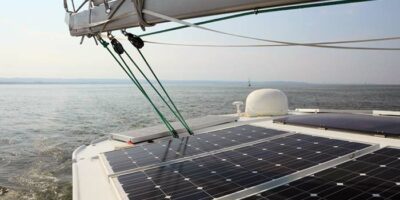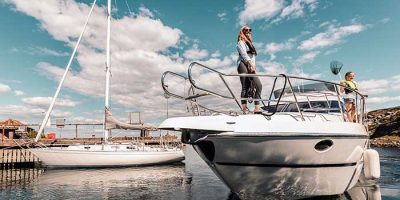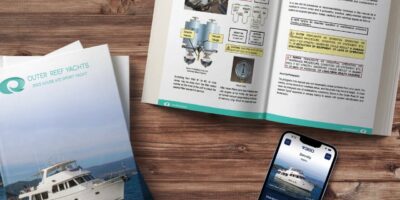Spring Engine Startup
Shake off the cobwebs of winter with this system-by-system commissioning plan. The first engine startup marks the beginning of the season.
- January 25, 2024
Getting your boat ready for another season’s use is one of the joys of springtime. Lots of great emotions are awakened; the possibilities for new boating adventures seem endless. Making sure your boat is ready for all the fun is a great responsibility. Even if you’re Johnny-on-the-spot when it comes to winterizing, there’s still a lot to be done to ensure trouble-free outings.
If your winterizing regimen leaves something to be desired, now is the time to correct all of last fall’s mistakes. It may be easier to tackle the project if you divvy it up by systems — steering, fuel, engine, drive, cooling, for starters. It’ll go faster this way, and there will be less chance to forget something important. There’s also cleaning and polishing to finish off after the systems checkups are complete.
Visual Once-Over
For those who have covered up the boat over the winter months, the first step is to check carefully for bees’ nests and other potential dangers (skunks, snakes, cats) before pulling the cover off. The warmer the temperature, the more potential for bees and other critters inside. Pulling the cover off will reveal what needs to be done from the outside in. Before the cleanup commences, it’s best to go through the rig and engine looking for problems. Even though your visual inspection may not have revealed critters, take a second look for small bees’ nests — often-times bees or wasps will make small, almost undetectable nests in near-impossible locations. These little nests are most often ones that will cause problems for you out on the water — for example, in the overboard telltale water indicator on an outboard, in the water intakes, and in the fuel tank vent outlet. If you find any of these “mud dauber” nests, clear them out completely before going boating.
Steering And Controls
Steering and shift/throttle controls are critical and failure to maintain them could cause an accident. They should be your first priority. For cable systems, ensure they work smoothly, operate properly, and are lubricated with marine-grade grease.
Hydraulic steering systems should be properly bled to purge air bubbles and checked to ensure they work properly (see “Caring For Your Hydraulic Steering“). Shift and throttle should be checked with the engine running on a flusher, or in the water tied to the dock. Shift the engine into forward and reverse from neutral and back again. Make sure the propeller stops rotating when the engine is shifted to neutral. Remove the propeller for this check if checking on a flusher; you will still be able to see the propeller shaft rotating as you shift gear.
Prop Choice: Teenagers wakeboarding like a different ride than the parents sightseeing, so why not have propeller choices that match the need? It’s like having two different boats. Think of it as switching from “normal” to “sport” mode in your car!
Fuel System
The engine can’t run if it can’t get fuel. Fuel system checking and maintenance have never been more important, thanks to the havoc that alcohol-extended fuels can wreak on fuel lines, filters and components. For our article on full fuel system checkup, see “Fuel System Checkup“.
Tip: Compromised fluids need to be replaced and maybe even flushed, prior to the next use. Brake fluid is less effective when mixed with water and can damage internal parts.
Batteries And Electrical
So you don’t get any nasty surprises on the water the batteries should be charged and checked to ensure that they will hold a charge. The terminals and cable ends should be cleaned and checked for tightness. A visual once-over to ensure that they’re secured and can’t tip over is good practice. Lights, bilge pump, horn, gauges, and all other accessories should be checked for proper operation and repaired if necessary.
Fire Up The Engine
Sterndrives must have the block water plugs replaced in their proper locations before running the engine. Belts and hoses should be checked for tightness and cracks. If it wasn’t changed in the fall, the engine oil and filter should be changed now (and don’t forget next fall!).
The engine should be connected to a water source (with a flush muff or similar device) and started; it should be allowed to reach operating temperature while running at idle, and while checking for proper cooling (the telltale water stream from the engine) and water leaks. All fittings (tilt tube, swivel bracket, hood latches, etc.) should be greased. The gear case should be checked for damage along with the propeller and propeller shaft.
If it wasn’t done in the fall, the gear case lube should be drained, checked for contamination (milky = water ingestion and seal failure, dark and stinky = potential gear and bearing damage), and refilled with fresh lubricant. Any corrosion should be sanded down, prepped, and repainted. The entire outboard cowling should be given a coat of wax to protect it from the water and sun.
Inspect The Hull
Check the boat topsides carefully for cracks, loose rub rail and cleats, and a damaged windshield or frame. Next, climb under the trailer and inspect every inch of the hull. You might be surprised at what you find. Nicks, chips, and dings (especially those through the gelcoat and into the fiberglass) should be repaired before the season starts. On aluminum hulls, check for cracks, missing or loose rivets, and broken welds. While you’re under there, check the trailer for rust, broken welds, rotted bunks, and deteriorating bunk carpet. Check the trailer lights and wiring; check the tires for weather checking and tread wear. Check the bearings and grease, and change if necessary. The winch, tongue jack, and coupler/safety chains must be inspected as well. Finally, don’t forget to renew your boat and trailer registration! A ticket for expired tags is not a fun way to interrupt your first outing.
John Tiger
Contributor, BoatUS Magazine
About Vessel Vanguard
Vessel Vanguard is a leading marine safety and maintenance management software provider dedicated to revolutionizing the maritime industry. With a commitment to innovation and excellence, Vessel Vanguard delivers cutting-edge solutions to streamline operations and enhance vessel performance and safety.
Latest Industry Insights

Embracing E-Boating Efficiencies

Boat Fuel Systems

The Future of Boats & Boating

Yacht Navigation Light Inspection
View All of Our Industry Insights
Navigate maritime with the latest news, practical how-to guides, insightful analyses and more.
Text and photos © 2020 Steve D’Antonio Marine Consulting, Inc.
